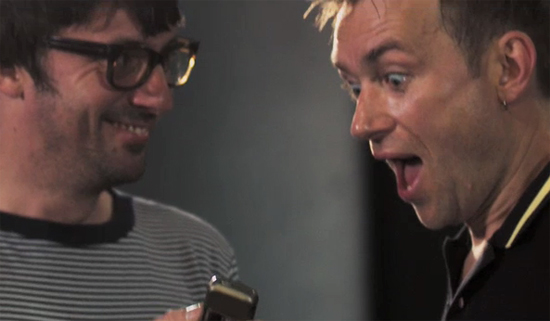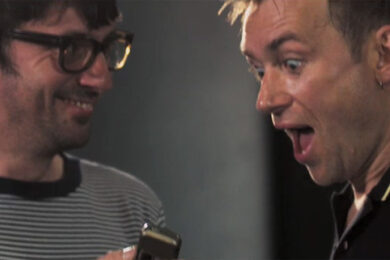"Whoohoo! When I feel heavy metal…"
Rockumentaries by their very nature start with the conceit that you will be interested enough in the artists in focus to warrant a film about their lives, their points of view, their innermost feelings and their battles with each other, or with illicit substances/ nefarious liquids/inner demons (delete as applicable). In an age where naughty children download all their pop music for free, it’s easy to forget that groups from here on in are unlikely to taste the sort of success Blur had. That’s not to mention the fact that being able to have a ‘relationship’ with a group via Twitter or MySpace rather erodes a sense of mystique. Graham Coxon may have spent several years drinking himself silly in the Good Mixer with painter decorators in full view of Camden’s rich array of 90s hipsters, but on the whole as British bands go, they are one of the last untouchables, proper popstars tucked away in the Cotswolds making cheese, or hiding behind cartoons drawn by Jamie Hewlett.
The fuss Blur’s shows in Hyde Park generated was phenomenal, and for anyone of a certain age in London and on Facebook, the reaction was genuinely startling, vying with the death of Michael Jackson and the onslaught of snow, as something people seemed utterly captivated by. Oasis enthusiasts could only look on and scratch their heads, as is their wont. Blur are one of the last bands left that a significant proportion of people want to know about, their lives representing a soap opera for a generation who tuned into This Life en masse.
Interest is one thing, but actually making a film where anyone comes out with any credibility at all is harder than it looks, so credit must go to the film makers. It may not have been so, had Spinal Tap, the 1984 mockumentary about a British band planning a North American tour while struggling to maintain interest and stop relationships from disintegrating, not been so incisive and hilariously astute. So good is Spinal Tap that it not only became the blueprint for spoofs, it also became the blueprint for serious music documentaries. Like a lascivious Anthony Quinn, the Tap is still siring imitations, and there is no doubt that the Daddy of rock movies begat No Distance Left to Run. While other classic comedies date depressingly, Spinal Tap seems more current than ever, with shows like The Office and Curb Your Enthusiasm indebted to Rob Reiner for what was then groundbreaking, and bizarrely is still seen as groundbreaking today. As comedian and author David Baddiel wrote recently: "The single-camera, non-audience form that is now considered modern is at this point in time, the established cultural norm."
Not that No Distance Left to Run is a comedy, though there are certainly hilarious moments. Damon Albarn inarticulate onstage rambling, triggered by spotting the magniloquent Will Self towering over the crowd at a fans only show, is comedy gold; while Coxon ordering two Crunchies on the rider is pure Nigel Tufnel. The film is less about the band as a unit, and more about their interpersonal relationships, the breakdown of friendships and the rekindling of affection between grown-up men, able to express their feelings as pride and ego dissipate with the ageing process. On the whole it is actually rather touching, just as Spinal Tap is. The focus is mainly on the two most important constituents of the band, Albarn the singer and Coxon the guitarist. Predictably Dave Rowntree is hardly present, though he was always the most peripheral and remote figure in Blur. Alex James’ observations are smart, but he doesn’t really say anything that wasn’t already in his book A Bit Of A Blur. Maybe he’s saving up any new insights for a future book, given his need to keep working to pay for the upkeep of the farm.
It could have all turned out differently if the main characters were allowed to wallow in self-indulgence, as Metallica did in their jaw-droppingly vainglorious 2004 documentary Some Kind Of Monster, a piss-yourself funny and painful dissection of a bunch of men with far too much money and self-regard. If Spinal Tap was savvy, Some Kind of Monster proved that in some ways it didn’t go far enough in lampooning risible clowns like Metallica. Coxon, who had a well-documented battle with alcoholism, maybe veers closest to therapy, but his self-awareness and timidity never allows him to tread anywhere near Metallica territory, while Albarn comes out of the whole exercise very well, something that hasn’t happened on film before; his philosophical and relaxed attitude to the past is in stark contrast to the angry agitator we’re reminded of throughout, and the grown-up Albarn is surprisingly likable.
Blur, like Spinal Tap, are survivors, and the film is left open-ended regarding what the future holds. There appear to be no current plans for the band to continue, but never says never. There are literally millions of people who’d relish Blur turning it up to 11 again.



